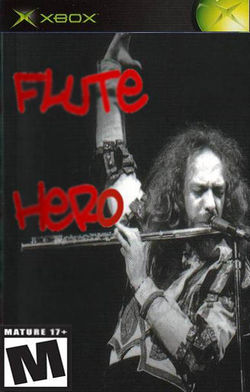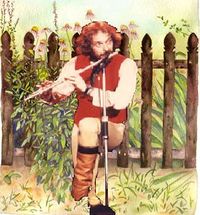Flute Hero
| Flute Hero | |
|---|---|
 Ian Anderson kicks it old school, woodwind-style | |
| Developer(s) | Square-Enix |
| Publisher(s) | Bandai and Flutopia Industries |
| Platform(s) | Xbox |
| Port | Any one in a storm |
| Release | Late February 2007 |
| Genre | Rhythm-PG |
| Rating | \m/ |
| Would Alexander the Great play this? | Only as means of suicide |
Flute Hero was a game released by Japanese gaming giants Square-Enix in first quarter 2007. It was released as a counter to the American made Guitar Hero, which was in turn a counter to the Japanese Dance Dance Revolution, which was in turn in turn a counter counter to a Counterstrike mod called Quarter Counter Counts Quarter Counts. It never caught on with the American audience it was aimed at or the Japanese audience that it hit by accident. In fact, the only people who enjoyed the game were the Somalians that found the two million unsold games when they were dumped over their country on garbage day, and even then all the Somalians did was eat it as nutrition for the DVD-CD's scarce amounts of fiber.[1]
Origin[edit | edit source]
Flute Hero was a collaboration between developer Square-Enix and mega-publisher Bandai, who brought total Japanese domination to the rhythm market back in the days of DDR, PaRappa da Rappa, and ReRun's Rhythmic Get Down! Featuring the cast of What's Happening? Flute Hero's executive producer Shigaryu Minomya was a professional Japanese flute player on the side and was the brainchild of the whole idea from the start.
The way Guitar Hero appealed to the younger crowd, Mr. Minomya expected to ship Flute Hero to the same player base, but failed miserably. Growing up on a cloistered farm for most of his adult life with no friends but his woodwind instruments, his expectations were warped from the very beginning. Little did Mr. Minomya know that there were practically no bands that featured a flute and were simultaneously also able to rock. This small flaw would cause some issues when the developers were finding suitable tracks for the game.
Development[edit | edit source]
Being the unintelligent plutocrat he was, Mr. Minomya picked the most successful Japanese video game developer to make the game with his money. This was the second huge mistake, since the company he almost-randomly picked happened to be RPG gods Square-Enix, who knew more about Australian dodos than they knew about making rhythm games. President and CEO Yoichi Wada was less than pleased with this project, but picked it up on a whim, since Minomya was willing to fund the enterprise with his own corn money.
Release[edit | edit source]
This is when Mr. Minomya really proved to the entire company of Square-Enix that he was a true, unique, one-of-a-kind king among dumbasses. Mr. Minomya had hardly enough money to guarantee release onto the public market overseas, so he resorted to get the games to retail stores in America the old fashioned way: pirating. Square, misjudging the definition of "pirating," lent him a few sky pirate-style airships, loaded them with copies of Flute Hero, and they set a course for the United States.
Sadly, due to extremely poor judgment once more resulting from his isolated life on the Osakan corn fields, the console Minomya released Flue Hero on wasn't quite the one kids played anymore. By attempting to connect with teenagers in the states, he released the game as an Xbox exclusive a full two years after the console went completely and utterly defunct. This made it the only release on the platform since G Rated Talking Animal Movie: The Game!
Gameplay[edit | edit source]

Flute Hero, much like Guitar Hero, featured a plastic controller shaped like the instrument in question, in this case a flute[2]. Mr. Minomya guided Square Enix, whose innovation genes were rusty from many formulaic and linear projects, in the making of the controller. What resulted became widely hailed as: "An ugly and clunky piece of trash", "The misshapen child of a hunk of plastic and a cheap dildo" and "Quite frankly, an unresponsive piece of shit and an eyesore at the same time."
The controls were similar to Guitar Hero in that there are color-coded keys on the controller which, when pressed down at the right intervals, hit the notes. The difference between the two is that, as opposed to Guitar Hero which makes you strum a separate control at the mouth of the guitar as well, the player needs to blow into the yellow port while pressing the keys to hit notes. According to Mr. Wada: "It seemed like a good idea at the time... until the deaths rolled in."
Yes, the biggest complaint about Flute Hero wasn't about the abysmal looks, idea or tracks, but it was about the controls. Out of twenty-five test subjects, four died attempting to rack up large combos[3]. Square Enix knew the feature absolutely had to go because of that, but Mr. Minomya threatened to pull funding if anything about the game[4], especially a fundamental (if deadly) feature, was changed. Square-Enix figured they had nothing to lose since they didn't actually care about the game and his funding was the only funding the game got in the first place, but being the brave souls they were, they stuck around.
Statistics[edit | edit source]
- Copies distributed: 2.05 million
- Copies sold: Several dozen (bargain bin)
- Total amount spent by Mr. Minomya: 2.08 billion ¥ (17 million USD)
- Total amount spent by developer Square Enix: 288 ¥ in parking tickets (2 USD)
Playable songs and controversy[edit | edit source]
As mentioned previously, Mr. Minomya wanted to aim Flute Hero at a younger audience, which proved a difficult task to accomplish. This time Minomya realized his mistake, but being such a die hard flutist, reconsidering the choice of instrument was impossible. Instead he delved into dozens of archives in search of bands featuring flute players, optimistic to find dozens of American artists unknown to him. He found Jethro Tull, Jethro Tull, and only Jethro Tull. Mr. Minomya, however, had a plan.
When he submitted the track list to Square-Enix for approval[5], the list looked like one of the What's wrong with this picture? pages on the back cover of Highlights for Kids. In an effort to outwit the brass at Square, he took the five songs by Tull on the list and listed each one under a different pseudonym without the band's permission, then buried them all under over 50 Japanese flute/Irish Whistle remixes and folk songs.
Can you spot the differences?
- Living in the Past as made famous by Jethro Tull
- Bouree as made famous by Ian Anderson
- Teacher as made famous by Jethro Tull featuring Ian Anderson
- Aqualung as made famous by Eric Sanderson and Jethro from the Beverly Hillbillies
- Hymn 43 as made famous by KC and the Sunshine Band
Extra Songs
- Firth of Fifth as made famous by Faux Gaye
- I talk To the Wind as made famous by Fling Plimshole
- Goliath as made famous by Venus Electricians
- Owner Of The Lonely heart as made famous by No
- Jerusalem as made famous by Jewish Nerd
Also of note is that Aqualung doesn't even feature the flute, and Hymn 43 is actually a misnamed and bootleg version of Shake your Booty.
Jethro Tull Controversy[edit | edit source]
It wasn't long after the American release of the game when Jethro Tull got wise to what was going on, and they started taking action. Most members and former members alike considered taking it to the courts, but Ian Anderson was more than displeased:
| “ | I should have been happy. I woke up one day not too long ago, got the mail, and noticed a heavily stamped envelope from some place in Japan I never heard of. Enclosed was this check for 5,000 dollars in royalties; something was definitely afoot, so I did some research and discovered this... game. Yes, I should have been happy, but I wasn't. I had to play this goddamned awful game for over ten hours just to even find one of my songs, and it just had to be that pretentious version of Bouree I recorded twenty years ago when I was still tripping balls on mescaline!
The bastard who developed this game decided to make my songs unlockables behind mountains and maountains of terrible Japanese flute muzak. It was bad enough that it was an awful game to play, but the fact that I almost went into cardiac arrest getting a 200 combo on the worst rendition of Flight of the Bumblebee I've ever heard—just to unlock one of my worse songs—was the last straw. |
” |
On March 19th 2007, two weeks after the game's release, Mr. Anderson, escorted by a bevy of bodyguards, purchased a bayonet-tipped oboe from a local hardware store and bought two tickets to Osaka. Mr. Minomya was forced into hiding for months, and only very recently resurfaced under a new identity in Juno, Alaska.
Nobody would recognize the old and haggard man, sitting on a park bench. His riches were gone, snot ran from his nose, his greasy fingers smearing shabby clothes... oh, Minomya, who had been thick as a brick his whole life, threw away his whole life over a single terrible game.
Footnotes[edit | edit source]
- ↑ The Somalians, most notably orphans, later complained that it was "way too bitter" and wished that "the douchebags who did this brought some salt too"
- ↑ For the better and more dedicated players in for a challenge, a piccolo version is also available
- ↑ Another great feature they added on was that the second you stop blowing, you lose your combo, even if there isn't anything to hit anymore (that's what she said).
- ↑ "My baby", he would later call it during his Cave Monster phase of game-making
- ↑ Which didn't matter anyway since he had complete control of the project, but it's still considered polite.
